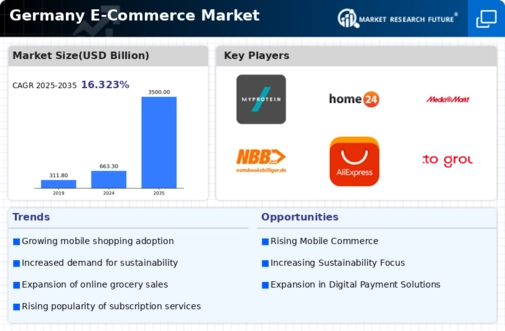Rising Consumer Expectations
In the e commerce market, consumer expectations in Germany are evolving rapidly. Shoppers are increasingly demanding faster delivery times, seamless returns, and personalized shopping experiences. A recent survey indicates that 70% of consumers expect their orders to be delivered within 24 hours, which poses a challenge for retailers to optimize their logistics and supply chain operations. Additionally, the emphasis on customer service is paramount, as consumers are more likely to abandon their carts if they encounter difficulties during the purchasing process. This rising expectation compels businesses to innovate and enhance their service offerings, which could lead to increased customer loyalty and retention in the e commerce market.
Growth of Online Payment Solutions
The e commerce market in Germany is witnessing a notable increase in the adoption of diverse online payment solutions. As consumers become more comfortable with digital transactions, the demand for secure and efficient payment methods is rising. Payment options such as digital wallets, buy now pay later (BNPL) services, and cryptocurrencies are gaining traction. Recent statistics reveal that around 45% of online shoppers in Germany prefer using digital wallets for their purchases, reflecting a shift in consumer behavior. This growth in online payment solutions is likely to enhance the overall shopping experience, thereby driving further growth in the e commerce market. Retailers that adapt to these payment preferences may find themselves at a competitive advantage.
Sustainability and Ethical Consumerism
Sustainability is emerging as a critical driver in the e commerce market in Germany, as consumers increasingly prioritize ethical considerations in their purchasing decisions. A significant portion of the population, approximately 60%, indicates a willingness to pay a premium for products that are sustainably sourced or produced. This shift towards ethical consumerism is prompting retailers to adopt more transparent supply chains and eco-friendly practices. Companies that align their operations with sustainability principles may not only enhance their brand image but also attract a growing segment of environmentally conscious consumers. As awareness of environmental issues continues to rise, the integration of sustainability into business models is likely to become a defining characteristic of the e commerce market.
Technological Advancements in E Commerce
The e commerce market in Germany is experiencing a surge in technological advancements, which are reshaping the landscape of online retail. Innovations such as artificial intelligence (AI) and machine learning are being integrated into various platforms, enhancing customer experience and operational efficiency. For instance, AI-driven chatbots are increasingly utilized for customer service, providing instant support and improving user satisfaction. Moreover, the adoption of augmented reality (AR) is allowing consumers to visualize products in their own environment before making a purchase. According to recent data, approximately 30% of German consumers express a preference for retailers that offer AR features. This trend indicates that technological advancements are not merely supplementary but are becoming essential for competitiveness in the e commerce market.
Impact of Social Media on Shopping Behavior
The influence of social media on shopping behavior is becoming increasingly pronounced within the e commerce market in Germany. Platforms such as Instagram and Facebook are not only serving as marketing tools but are also facilitating direct shopping experiences. Approximately 50% of German consumers report that they have made purchases directly through social media channels. This trend suggests that social media is transforming into a vital sales channel, compelling retailers to develop strategies that leverage these platforms effectively. As social media continues to shape consumer preferences and behaviors, businesses that fail to adapt may struggle to maintain their market share in the e commerce market.























Leave a Comment